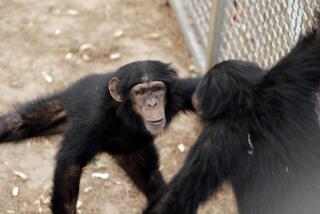Q&A: What it’s like to be interviewed for a job by Koko the gorilla: ‘She had a lot to say’
There aren’t many people who’ve had to impress a gorilla for a job interview, but Mary Lee Jensvold is one of them.
The interviewer in question was Koko, the western lowland gorilla who made a name for herself by learning American Sign Language and demonstrating for the world that animals have more intelligence and emotional depth than humans usually give them credit for. Jensvold was applying for a job as Koko’s caretaker.
“It was one of the most transformative experiences of my life,” Jensvold recalled this week after learning that Koko passed away in her sleep this week at the age of 46. “Before then, I had only ever talked to humans, and it was like, ‘Wow, we are really talking!’ It was really an amazing experience to meet another species and have a conversation with her.”
Now a professor in the Primate Behavior and Ecology Program at Central Washington University, Jensvold has worked with chimpanzees who communicate with sign language since 1986.
She met Koko a second time more recently, when one of her graduate students began working with the gorilla.
“She’s an acquaintance, if you will,” Jensvold said. “But I know she was very loved by everybody that was in her life. There are some hurting people today, that is for sure.”
Here are more of Jensvold’s reflections on Koko’s life and what she taught humans.
What was the significance of Koko’s life?
Koko told us what it is like to be a gorilla, and she told us in a language that humans can understand.
One of the things she and the other signing apes taught us is about the continuity of species. The message coming out of them is that humans aren’t necessarily so special.
Did Koko use language like humans do?
Koko and the other signing apes absolutely use language the same way people do. She was commenting on the world around her and signing about her activities, her day and her thoughts.
I liken it to talking to a child — not because she wasn’t mature, but because she was in a dependent relationship. The conversation you would have with her is like the conversation you would have with a child or an elderly person in your care.
Could any gorilla learn to sign like Koko?
Koko and Washoe [the chimpanzee who was the first member of the ape family to learn sign language] were not super-genius apes. Any ape that was in that environment would pick up sign the same way.
And Koko learned her signs the same way that human children learn signs and words — by being immersed in it.
Why haven’t more apes learned sign language?
When the Koko project started, that was sort of the heyday of the sign-language studies. So there was Koko, and the Gorilla Foundation had another male gorilla, Michael, who signed. And then the work was done with Washoe and four other chimps.
We learned so much from them about what they are thinking and feeling, and it gives us a window into their mind.
But we know keeping them in captivity is not a good situation for them. They end up being a displaced person, if you will. They have no home. Baby apes belong with their mothers.
We can give them lots of things, but we can never give them their freedom. So I feel strongly that the research should never be replicated, ever.
What was the job interview with Koko like?
It was 1985, and I was a fresh graduate with a bachelor degree. There was a job to work with Koko as a caregiver and I applied.
First I met with Francine Patterson and Ronald Cohn, who co-founded the Gorilla Foundation where Koko lived. The next part of the interview was to meet Koko, who had lived all her life in a trailer.
I met her through a sliding glass door, and she invited me to come inside so we were separated by a fence. I brought her gifts — a hat and scarf — and gave her those gifts. But she didn’t pick me.
This interview has been edited for clarity.
MORE IN SCIENCE
Koko, the gorilla whose sign language abilities changed our view of animal intelligence, dies at 46
Surprising discovery about viruses and Alzheimer’s disease could open new avenues for treatment
Extinct species of gibbon discovered in an unlikely place — the tomb of a Chinese noblewoman







